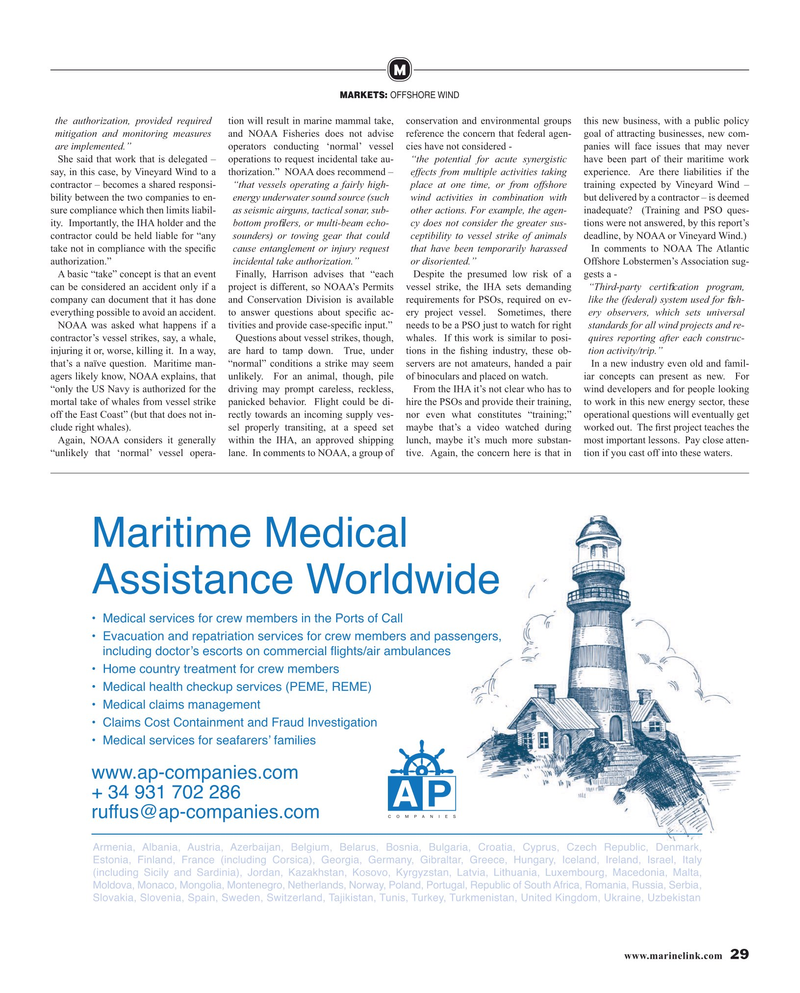
Page 29: of Maritime Reporter Magazine (August 2019)
The Shipyard Edition
Read this page in Pdf, Flash or Html5 edition of August 2019 Maritime Reporter Magazine
M
MARKETS: OFFSHORE WIND the authorization, provided required tion will result in marine mammal take, conservation and environmental groups this new business, with a public policy mitigation and monitoring measures and NOAA Fisheries does not advise reference the concern that federal agen- goal of attracting businesses, new com- are implemented.” operators conducting ‘normal’ vessel cies have not considered - panies will face issues that may never
She said that work that is delegated – operations to request incidental take au- “the potential for acute synergistic have been part of their maritime work say, in this case, by Vineyard Wind to a thorization.” NOAA does recommend – effects from multiple activities taking experience. Are there liabilities if the contractor – becomes a shared responsi- “that vessels operating a fairly high- place at one time, or from offshore training expected by Vineyard Wind – bility between the two companies to en- energy underwater sound source (such wind activities in combination with but delivered by a contractor – is deemed sure compliance which then limits liabil- as seismic airguns, tactical sonar, sub- other actions. For example, the agen- inadequate? (Training and PSO ques- ity. Importantly, the IHA holder and the bottom pro? lers, or multi-beam echo- cy does not consider the greater sus- tions were not answered, by this report’s contractor could be held liable for “any sounders) or towing gear that could ceptibility to vessel strike of animals deadline, by NOAA or Vineyard Wind.) take not in compliance with the speci? c cause entanglement or injury request that have been temporarily harassed In comments to NOAA The Atlantic authorization.” incidental take authorization.” or disoriented.” Offshore Lobstermen’s Association sug-
A basic “take” concept is that an event Finally, Harrison advises that “each Despite the presumed low risk of a gests a - can be considered an accident only if a project is different, so NOAA’s Permits vessel strike, the IHA sets demanding “Third-party certi? cation program, company can document that it has done and Conservation Division is available requirements for PSOs, required on ev- like the (federal) system used for ? sh- everything possible to avoid an accident. to answer questions about speci? c ac- ery project vessel. Sometimes, there ery observers, which sets universal
NOAA was asked what happens if a tivities and provide case-speci? c input.” needs to be a PSO just to watch for right standards for all wind projects and re- contractor’s vessel strikes, say, a whale, Questions about vessel strikes, though, whales. If this work is similar to posi- quires reporting after each construc- injuring it or, worse, killing it. In a way, are hard to tamp down. True, under tions in the ? shing industry, these ob- tion activity/trip.” that’s a naïve question. Maritime man- “normal” conditions a strike may seem servers are not amateurs, handed a pair In a new industry even old and famil- agers likely know, NOAA explains, that unlikely. For an animal, though, pile of binoculars and placed on watch. iar concepts can present as new. For “only the US Navy is authorized for the driving may prompt careless, reckless, From the IHA it’s not clear who has to wind developers and for people looking mortal take of whales from vessel strike panicked behavior. Flight could be di- hire the PSOs and provide their training, to work in this new energy sector, these off the East Coast” (but that does not in- rectly towards an incoming supply ves- nor even what constitutes “training;” operational questions will eventually get clude right whales). sel properly transiting, at a speed set maybe that’s a video watched during worked out. The ? rst project teaches the
Again, NOAA considers it generally within the IHA, an approved shipping lunch, maybe it’s much more substan- most important lessons. Pay close atten- “unlikely that ‘normal’ vessel opera- lane. In comments to NOAA, a group of tive. Again, the concern here is that in tion if you cast off into these waters.
Maritime Medical
Assistance Worldwide • Medical services for crew members in the Ports of Call • Evacuation and repatriation services for crew members and passengers, including doctor’s escorts on commercial flights/air ambulances • Home country treatment for crew members • Medical health checkup services (PEME, REME) • Medical claims management • Claims Cost Containment and Fraud Investigation • Medical services for seafarers’ families www.ap-companies.com + 34 931 702 286 [email protected]
Armenia, Albania, Austria, Azerbaijan, Belgium, Belarus, Bosnia, Bulgaria, Croatia, Cyprus, Czech Republic, Denmark,
Estonia, Finland, France (including Corsica), Georgia, Germany, Gibraltar, Greece, Hungary, Iceland, Ireland, Israel, Italy (including Sicily and Sardinia), Jordan, Kazakhstan, Kosovo, Kyrgyzstan, Latvia, Lithuania, Luxembourg, Macedonia, Malta,
Moldova, Monaco, Mongolia, Montenegro, Netherlands, Norway, Poland, Portugal, Republic of South Africa, Romania, Russia, Serbia,
Slovakia, Slovenia, Spain, Sweden, Switzerland, Tajikistan, Tunis, Turkey, Turkmenistan, United Kingdom, Ukraine, Uzbekistan www.marinelink.com 29
MR #8 (26-33).indd 29 8/7/2019 9:18:43 AM

 28
28

 30
30
